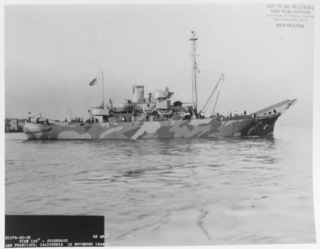
USS Pakana (AT–108) was an Abnaki-class fleet ocean tug. It was named after the Pakana, a Native American tribe of Texas. This ship saw service in the Pacific theater of World War II, and was later transferred to the United States Bureau of Mines for use in Alaska before being deliberately sunk in 1975.

USS Butternut (AN-9/YN-4/ANL-9/YAG-60) was laid down as a yard net tender on 11 March 1941 at Houghton, Washington, by the Lake Washington Shipyard; launched on 10 May 1941; and placed in service at the Puget Sound Navy Yard on 3 September 1941.
USS Tekesta (AT-93) was Navajo-class fleet tug built during World War II for the United States Navy. Shortly after being built, it was crewed by trained Navy personnel and sent into the Pacific Ocean to provide tug service to damaged ships in battle areas. For successfully performing this dangerous work, she was awarded four battle stars by the war's end.

USS Lipan (AT-85) was a Navajo-class fleet tug constructed for the United States Navy during World War II. Her purpose was to aid ships, usually by towing, on the high seas or in combat or post-combat areas, plus "other duties as assigned." She served in the Pacific Ocean during World War II and the Korean War. She was awarded two battle stars for World War II and four battle stars for the Korean War.
USS Mataco (AT-86/ATF-86) was a Navajo-class fleet tug constructed for the United States Navy during World War II. Her purpose was to aid ships, usually by towing, on the high seas or in combat or post-combat areas, plus "other duties as assigned." She served in the Pacific Ocean and was awarded five battle stars for World War II, four battle stars for the Korean War, and seven campaign stars for Vietnam War service.

USS Shackle (ARS-9) was a Diver-class rescue and salvage ship commissioned by the U.S. Navy for service in World War II. She was responsible for coming to the aid of stricken vessels.

USS Snowbell (YN-71/AN-52) was a Ailanthus-class net laying ship which served the U.S. Navy during World War II. She operated in the Pacific Ocean until she was destroyed by Typhoon Louise off Okinawa, 9 October 1945.
USS Chinquapin (YN-12/AN-17) was an Aloe-class net laying ship built for the United States Navy during World War II. Originally ordered as USS Fir (YN-2), she was renamed and renumbered to Chinquapin (YN-12) in October 1940 before construction began. She was launched in July 1941, and completed in October 1941. Placed in service at that time without being commissioned, she was commissioned in January 1943, and decommissioned in March 1946. She was placed in reserve at that time and scrapped in 1976.
USS Catclaw (AN-60/YN-81) was an Ailanthus-class net laying ship which served with the U.S. Navy during World War II. Catclaw served in both the Atlantic Ocean and the Pacific Ocean theatres of the war. Post-war she was decommissioned in China, and transferred to the Republic of China.

USS Lancewood (AN-48/YN-67) was an Ailanthus-class net laying ship built for the United States Navy during World War II. In service in the Pacific during the war, she earned one battle star. After her February 1946 decommissioning, she was sold to France as Commandant Charcot. Her fate is not reported in secondary sources.
USS Corkwood (AN-44/YN-63) was an Ailanthus-class net laying ship which served with the U.S. Navy in the western Pacific Ocean theatre of operations during World War II. Her career was without major incident, and she returned home safely after the war with one battle star to her credit.

USS Teak (AN-35/YN-30) was an Aloe-class net laying ship which served with the U.S. Navy in the Pacific Ocean theatre of operations during World War II. She was assigned to serve the U.S. Pacific Fleet with her protective anti-submarine nets and earned two battle stars and other commendations for her bravery.
USS Mango (AN-24/YN-19) was an Aloe-class net laying ship which was assigned to serve the U.S. Navy during World War II with her protective anti-submarine nets.

USS Locust (YN-17/AN-22) was an Aloe-class net laying ship built for the United States Navy during World War II. She was later transferred to the French Navy as Locuste (A765). She was sold to Malaysian owners but sank after striking a reef off Cikobia Island, Fiji, on 30 July 1978. She was towing the former French ship Scorpion, which also sank.

USS Elder (AN-20/YN-15) was an Aloe-class net laying ship which was assigned to serve the U.S. Navy during World War II with her protective anti-submarine nets.
USS Catalpa (AN-10/YN-5) was an Aloe-class net laying ship which was assigned to serve the U.S. Navy ships and harbors during World War II with her protective anti-submarine nets.

USS Aloe (AN-6/YN-1) was an Aloe-class net laying ship which was assigned to serve U.S. Navy ships and harbors during World War II with her protective anti-submarine nets.
USS Oneota (YN-110/AN-85) was a Cohoes-class net laying ship which was assigned to protect United States Navy ships and harbors during World War II with her anti-submarine nets. Her World War II career was short due to the war coming to an end, but she was retained post-war sufficiently long to participate in atomic testing at Bikini Atoll.
USS Passaconaway (YN-114/AN-86) – sometimes called USS Skakamaxon -- was a Cohoes-class net laying ship which was assigned to protect United States Navy ships and harbors during World War II with her anti-submarine nets. Her World War II career was short due to the war coming to an end, but, post-war, she continued salvage operations, including those at Bikini Atoll, before being struck from the Navy in 1947.

USS League Island (AG-149/AKS-30) – also known as USS LST-1097 - was an LST-511-class tank landing ship launched by the U.S. Navy during the final months of World War II. League Island served as a supply and stores-issue ship for the U.S. 7th Fleet, and was decommissioned after the war.










